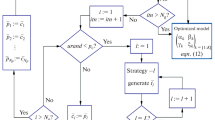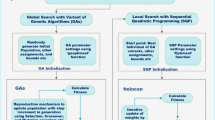Abstract
In this paper, a new approach has been proposed to design any arbitrary E-plane filters, including band-pass, and band-stop filters, with a desired frequency response. The proposed method is based on replacing all conventional resonators with a new form of a resonator, which is made of a patterned plane. The patterned plane is a metal plane with infinitesimal thickness that some of its parts, are removed. The introduced patterned plane is supported by a thin and low permittivity dielectric slab, and is located longitudinally in the middle of a rectangular waveguide, parallel to the E-plane. To design the proposed filters, the scattering parameters of the structure should be calculated. For this purpose, a coupled set of electric field integral equations have been derived, and solved by method of moments. Then, a suitable cost function was defined, and optimized using genetic algorithm. MATLAB GA tool has been used to optimize the cost function. The proposed method facilitates and accelerates the optimization process in comparison to full wave simulator software. As examples, both band-pass, and band-stop E-plane filters have been designed. The results show that the proposed filter, in comparison to the conventional filters, has some advantages, such as frequency band selectivity, compactness, and the ability of adjustment to any desired frequency response. The results of designed structures are validated by HFSS simulator software.









Similar content being viewed by others
References
Arndt, F., Heckmann, D., Semmerow, H., et al.: Stop band optimized E-plane filters with multiple metal inserts of variable number per coupling element. IEE Proc. 133, 169–174 (1986)
Budimir, D.: Optimized e-plane band pass filters with improved stop band performance. IEEE Trans. Microw. Theory Tech. 45, 212–220 (1997)
Collin, R.E.: Foundations for Microwave Engineering. McGraw-Hill, New York (1996)
Ghajar, A., Ghorbaninejad, H.: Compact microwave impedance matching using patterned conducting planes. Appl. Comput. Electromagn. Soc. J. 30, 540–545 (2015)
Ghorbaninejad-Foumani, H., Khalaj-Amirhosseini, M.: Compact spatial band-pass filters using frequency selective surfaces. Prog. Electromagn. Res. C 21, 59–73 (2011)
Goussetis, G., Budimir, D.: Novel periodically loaded E-plane filters. IEEE Microw. Wirel. Comp. Lett. 13, 193–195 (2003)
Konishi, Y., Uenakada, K.: The design of a band-pass filter with inductive strip-planar circuit mounted in waveguide. IEEE Trans. Microw Theory Tech 22, 869–873 (1974)
Kozakowski, P., Deleniv, A.: New resonator arrangement for reduced size E-plane filters, microwave symposium digest (MTT). 2011 IEEE MTT-S Int., 1–4 (2011)
Mansour, R.R., Fouladian, J.: Analysis and design of extracted pole E-plane filters. Microw. Opt. Technol. Lett. 2, 286–291 (1989)
Matthaei, G., Young, L., Jones, E.M.T.: Band-Stop Filters: Microwave Filters, Impedance Matching Networks and Coupling Structures, Artech House. Mass, Dedham (1980)
Montejo-Garai, J.R., Ruiz-Cruz, J., Rebollar, J.M., et al.: In-line pure E-plane waveguide band-stop filter with wide spurious-free response. IEEE Microw. Wirel. Comp. Lett. 21, 209–211 (2011)
Ofli, E., Vahldieck, R., Amari, S.: Novel E-plane filters and diplexers with elliptic response for millimeter-wave applications. IEEE Trans. Microw. Theory Tech. 53, 843–851 (2005)
Author information
Authors and Affiliations
Corresponding author
Appendix
Appendix
The electric dyadic Green’s functions derived as follows.
where \(\varGamma_{mn} = \sqrt {\left( {m\pi /a} \right)^{2} + \left( {n\pi /b} \right)^{2} - k_{0}^{2} }\) is the propagation constant, \(k_{0}^{2} = \omega^{2} \mu_{0} \varepsilon_{0}\), \(k_{x} = m\pi /a\), and \(k_{y} = n\pi /b\). In Eqs. 22, 23, upper and lower sign corresponds to \(z \ge z',\) and \(z < z'\) respectively and the Neumann factor \(\varepsilon_{n}\) is given by:
Rights and permissions
About this article
Cite this article
Ghorbaninejad, H., Ghajar, A. Genetic algorithm design for E-plane waveguide filters. Opt Quant Electron 48, 468 (2016). https://doi.org/10.1007/s11082-016-0743-3
Received:
Accepted:
Published:
DOI: https://doi.org/10.1007/s11082-016-0743-3




